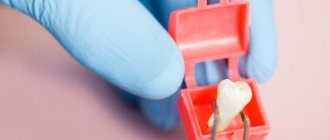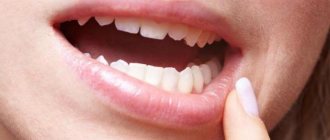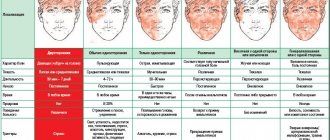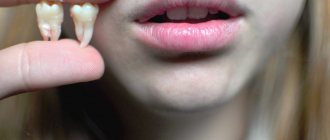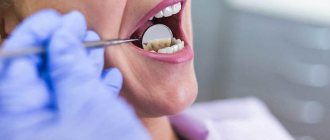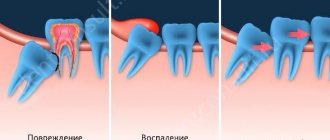Why does pain occur when a wisdom tooth is cut?
Eights rarely erupt without problems; in most cases, this process is long and painful, and often ends with a trip to the dentist. Why does a wisdom tooth cause so much suffering? Several factors can lead to increased pain:
- The growth of a tooth through bone tissue, which has already formed, is the main cause of pain.
- If the figure eight grows not upward, but sideways, at an angle or in the opposite direction, resting on adjacent teeth or jaw bone.
- There is not enough space in the mouth for teeth to erupt.
- The mucous membrane of the gum above the figure eight is inflamed.
- An infection has entered the canal through which the tooth grows.
- The figure eight is cut very slowly, and often appears already with caries.
- Pain can occur after poor quality treatment.
Propolis effectively relieves swelling and disinfects.
Oral diseases and headaches
- In most cases, pain symptoms are caused by caries . Inflammatory processes in teeth and destruction of enamel and dentin lead to the development of harmful microorganisms and are a favorable environment for the proliferation of bacteria. The virus penetrates the affected cavity, provokes inflammation of the pulp, which contributes to headaches.
If a person has an incorrect bite , dull pain in the parotid space, clicking in the jaw joints, as well as pain symptoms in the back of the head and crown of the head may occur.- When a tooth is removed, the body reacts with an immediate headache. Any surgical intervention that causes damage to bone tissue and trauma to the membranes is stressful for the body, especially if the “eight” is removed.
- Anesthesia during surgical removal can also provoke pain syndromes in the head, especially in the temple area. Ruptures of blood vessels and damage to nerve fibers lead to swelling in the ear area, as well as an unpleasant odor, indicating improper healing of the wound.
- Galvonism is a disease caused by metal crowns, in addition to painful sensations in the skull, it can cause discomfort in the oral cavity: a burning sensation under the denture, a sensation of metallic taste, and others.
- Infectious diseases of the oral cavity, sore throat, tonsillitis can be accompanied by pain syndromes in the head, radiating to the temporal region and back of the head, as well as an increase in temperature.
- Another cause is stomatitis .
- If the figure eight grows incorrectly, inflammation of the trigeminal nerve . This may cause facial muscles to twitch.
Main symptoms of teething
If eruption proceeds without deviations, it does not cause any particular trouble. How to understand that a wisdom tooth is growing? Its eruption is accompanied by the following symptoms: thickening and swelling of the gums, a feeling of slight bursting at the site of eruption, aching pain.
Unfortunately, eights rarely grow without complications; in most cases, this is a painful and lengthy process. The main symptoms that accompany complicated wisdom tooth eruption:
- The gums begin to hurt due to the fact that the sharp edges of the crown part rest against the mucous membrane. If eruption occurs without complications, the pain is quite tolerable. But if the pain intensifies and becomes aching, this indicates the development of an inflammatory process (read about inflammation of the periosteum here),
- It often happens that a wisdom tooth comes out and the gums, and later the cheek, swell. These are the main signs of pericoronitis - a complication that is accompanied by the gum hanging over the erupted part of the tooth - the hood,
- if the body temperature is elevated, this is a sign of an inflammatory process that can develop into purulent,
- sometimes the inflammatory process spreads to the masticatory muscles, making it difficult to open and close the mouth,
- One of the unpleasant moments is painful swallowing, which often indicates the development of a purulent abscess.
In what cases can pain radiate to the ear?
Often the causes of ear pain are various pathologies of the tissues of the oral cavity, which can be of infectious or non-infectious origin. Below are the most common causes of ear pain caused by poor dental health.
Wisdom tooth eruption
Wisdom teeth often have problems erupting, since there may not be enough space in the jaw and the tooth will grow at an angle, deforming the gums.
The process of teething and growth is accompanied by inflammation of the gum tissue, fever, weakness and pain, which can spread to the throat, area under the eyes and ears.
Upper eights are at greater risk of pain spreading to the ears because these teeth are closest to the hearing organs.
Cyst
A cyst forms if the tooth treatment was incorrect.
As a result, the painful area of the gum swells and suppurates. Inflammation quickly progresses and spreads throughout the tissues. If the problem is neglected and the cyst grows to an impressive size, then the entire corresponding side of the face will hurt. This inflammation can cause serious damage to the ear canals.
Trauma to teeth and/or soft tissues
Suspicion of this problem may arise when there is a throbbing, sharp pain in the ear.
A common case is tissue damage during surgery, when the tooth root or nearby tissues are damaged.
The gums in this place swell noticeably, and the tooth socket becomes inflamed.
Inflammation in the middle ear
There are also interdependencies of the opposite order: pain in the teeth can be caused by a problem in the ear canals.
A popular case of this nature is toothache due to inflammation in the middle ear, a special case of otitis media.
In this case, the patient experiences sharp, unremitting pain in one tooth or even in the entire jaw area.
Otitis
Otitis of any part of the ear can also be an example of an inverse relationship between teeth and ears.
Often, the causative agents of this disease are streptococci. With otitis media, a person complains of pain in the area of the chewing teeth on the side of the affected ear; unpleasant sensations are localized in the part of the jaw that is located closer to the back of the head.
Inflammation of the ternary nerve
The cause of pain in the ears or teeth can be directly their “connecting link” - the ternary nerve.
When an inflammatory process occurs in the ternary nerve, painful sensations appear spontaneously and have a “shooting” character. Associated symptoms may include unilateral facial flushing, difficulty chewing food, and unintentional contractions of facial muscles.
How to relieve pain?
A cutting figure eight can cause many serious complications. Therefore, at the first signs of pathological teething, contact your dentist.
In the vast majority of cases, complications that develop during the eruption of figure eights arise due to late seeking medical help.
If you can’t go to the dentist in the next few days, and the pain increases, you’ll have to cope on your own. Please note, do not trigger this condition, and as soon as the opportunity arises, immediately run to the doctor.
We present to you 5 effective methods on how to get rid of pain due to pathological eruption of wisdom teeth at home:
- medications at a pharmacy without a doctor's prescription:
- anti-inflammatory drugs: nimesulide, paracetamol, ibuprofen. They also effectively reduce elevated body temperature (read about temperature during teething here),
- painkillers: analgin, applications using local anesthetics,
- antiseptic solutions: Eludril, Chlorhexidine, Miramistin (more about Miramistin analogue drugs in this article),
- anesthetic gels: Metrogyl-Denta, Cholisal. These remedies relieve swelling, pain and soothe sore gums for a while.
At the pharmacy you can buy an effective remedy that is often used in dentistry - Maraslavin . The drug consists of natural ingredients. It is necessary to moisten a piece of cotton swab in the liquid and apply it to the sore gum. Repeat the procedure five to eight times a day. Maraslavin relieves swelling and provides good pain relief.
Herbal decoctions are an indispensable remedy for toothache.
- Traditional medicine recipes often save us from various diseases; these are natural ingredients that nature gave us in the form of medicinal herbs, inflorescences and bee products. As practice has shown, herbal decoctions effectively help in such cases:
- sage tincture : pour two tablespoons of dry herb into 0.5 liters of boiling water, leave to steep for an hour. Be sure to strain the product and rinse your mouth with it as often as possible until the symptoms disappear,
- Oak bark is a well-known remedy that relieves inflammation and swelling, and is also an excellent pain reliever. Take six tablespoons of oak bark and pour 0.4 liters of boiling water over them. Place over low heat and bring the liquid to a boil. When it boils, add four more tablespoons of sage to the broth; after a couple of minutes, remove the broth from the heat. Let the liquid cool, strain and rinse your mouth as often as possible,
- turnip is an effective remedy against toothache. Chop the vegetable, you will need 2-3 tablespoons, which you need to add water, bring to a boil and keep on low heat for 15 minutes. Cool the broth and rinse your mouth with it.
- calendula tincture : pour a teaspoon of inflorescences into 100 ml of boiling water, let it brew, strain and rinse the mouth. The liquid should be warm. You can use chamomile ,
- chicory root : Place a tablespoon of dried chicory root into a saucepan. Pour in a glass of boiling water and simmer over low heat for about five minutes. Cool the broth and strain. You need to rinse your mouth about four times a day.
- If your tooth hurts unbearably, but you can’t go to the pharmacy, you always have simple and effective products on hand - soda and salt . In 200 ml of water, stir a teaspoon of soda, salt and drop two or three drops of iodine. Rinse your mouth with this solution two to three times a day, but not very often, as it dries out the mucous membranes.
- Bee products are excellent for many dental ailments. If you do not have allergies, feel free to go to the pharmacy for propolis tincture. You need to dissolve 5-10 drops of tincture in 200 ml of warm water and rinse your mouth. This remedy perfectly kills infection, soothes inflamed gums and relieves swelling.
- A cold compress will help relieve your pain temporarily. Do not warm your cheek on the side of the cutting tooth under any circumstances! This will only speed up the inflammatory process and worsen the situation.
Important : the above methods will only help temporarily relieve pain during the period when the wisdom tooth is growing. Never be patient and go to a specialist at the first opportunity. The sooner you seek medical help, the lower the likelihood of developing complications.
How to relieve the condition yourself
1. You can use pharmaceutical drugs that are available without a prescription:
- Remedies for eliminating inflammation: Ibuprofen and Paracetamol;
- Painkillers: Analgin;
- Gels for gum pain relief: Metrogyl-Denta and Xolisal;
- Antiseptics: Miramistin, Chlorhexidine;
- Maraslavin lotions will relieve swelling and eliminate pain.
2. Decoctions of medicinal herbs. Complications during the eruption of a wisdom tooth are associated with injury to the surrounding gum tissue. Without help, the consequences can be serious. If there is throbbing pain and swelling in the problem area, you should consult a doctor. The danger is that the accumulated pus can quickly spread from the soft tissue of the jaw. Frequent rinsing with a decoction of oak bark, brine, tincture of sage, calendula or chamomile is an effective remedy for relieving swelling and pain relief. You can use a decoction of chicory root.
3. If there is no pharmacy nearby, you can use salt water and soda. It is useful to drop iodine into the solution.
4. Bee products help with dental problems - propolis tincture will relieve swelling, soothe inflamed gum tissue and stop the development of infection.
5. A cold compress will temporarily soothe a sore tooth.
All of the above methods can be used temporarily until you can go to the doctor. It should be remembered that the sooner this meeting occurs, the lower the likelihood of complications.
Remember: it is forbidden to heat the sore spot, as the development of the inflammatory process will only accelerate.
What to do when a wisdom tooth is cut - painful symptoms and how to cope with them?
When a wisdom tooth is cut, the symptoms of this process can cause severe discomfort.
The painful eruption of such teeth signals the onset of an inflammatory process, which is accompanied by terrible pain and causeless anxiety.
In such a situation, the most correct decision would be to visit an experienced dentist who can normalize the course of the process that has begun. If you ignore a visit to the doctor, the patient risks developing some complications with unpleasant consequences.
Why does pain occur when a wisdom tooth is cut?
If a wisdom tooth is cutting through and your gums hurt, this is a characteristic symptom of difficult eruption. The intervention of a dentist is the most common case of ridding the body of emerging problems.
The main reasons that stimulate pain during teething are:
- Poor quality treatment of adjacent teeth.
- Slow growth of figure eights with the onset of carious lesions.
- Penetration of infectious particles into the figure eight growth channel.
- Inflammation of the gums near the wisdom tooth.
- Lack of space on the gum for the erupting figure eight.
- Incorrect direction of growth (in the opposite direction, at an angle or to the side).
- Cutting a figure eight through the formed bone tissue structure.
The last reason is the most common when there is pain from the eruption of a wisdom tooth.
Where is the wisdom tooth located?
In the oral cavity of an adult, healthy person, there are 32 teeth on the upper and lower jaw. In the front part there are incisors - there are 4 of them at the top and bottom, and fangs - there are 2 of them. Behind them are symmetrically followed by premolars, small chewing teeth. And the very last, in the depths, are the main chewing teeth - molars. There are three of them on each side of the upper and lower jaw. The last, third molar, or eighth tooth in a row, is the notorious wisdom tooth.
Thus, a total of four wisdom teeth should erupt - one on each side, on the upper and lower jaw. A tooth is cut, as a rule, between the ages of 17 and 25, sometimes a little earlier or later. In rare cases, wisdom teeth remain under the gums until old age.
Main symptoms of teething
How to understand that a wisdom tooth is cutting? You can distinguish the painful eruption of the figure eight from other types of pain thanks to the following symptoms:
- Submandibular lymphadenitis (submandibular lymph nodes increase in size);
- Hidden infiltration (reproduction of pathogenic microorganisms on food debris not removed during the hygiene procedure);
- “Hood” (special covering over the area of the cut-out figure eight);
- Swelling of the gums;
- Pain when swallowing;
- Pain in the jaw.
How to relieve pain?
If a wisdom tooth is cutting, how to relieve pain at home?
In the case of the correct direction of growth (without the presence of a characteristic “hood”), a soda solution is effective.
To prepare it, you need to dissolve a teaspoon of baking soda in a glass of boiled water.
The resulting product copes well with toothache if you rinse your mouth with it twice a day.
Very relevant questions when a wisdom tooth is cut - how to numb the pain and what to rinse with? You can relieve pain using proven folk remedies. It is only recommended to first consult with an experienced dentist about such actions, so as not to cause unnecessary harm to your body.
Antiseptic solutions are excellent for relieving pain when teething.
They help not only reduce pain syndromes, but also disinfect injured gums.
The following are ideal antiseptic solutions:
- tincture of yarrow;
- oak bark decoction;
- steamed solution of pharmaceutical chamomile.
Physiological eruption
How many wisdom teeth a person has, at what age and how long it takes for a wisdom tooth to be cut is absolutely individual for each case. With physiological eruption, the patient does not feel additional problems with the growth of the figure eight.
Typically, such eruption is carried out without:
- Unnecessary troubles;
- Inconvenience;
- Deviations.
The physiological eruption of such teeth most often occurs with a feeling of mild discomfort. In this case, the formation of characteristic engorgement with thickening of the gums is often observed.
In medical practice, cases of banal physiological teething are described, when in addition to all the symptoms listed above, a slight tingling sensation was added.
However, the physiology of the growth of eights is very individual and can differ in its characteristics even when erupting from the lower and upper jaws.
Pathological eruption
With pathological eruption of figure eights, there is a high probability of the appearance of:
- Inflammation with feeling of low pressure. The reason for this is the formation of a separate focus with pus. Often, the pressure drops noticeably, indicating the development of phlegmon and rupture of the abscess capsule;
- Painful swallowing, indicating the possible onset of a purulent abscess. A developing abscess in the tongue area is especially dangerous, since in this case the likelihood of rapid spread of the disease through the soft tissues increases. Treatment of such cases is rarely complete without surgical intervention, which consists of making the necessary external incisions;
- Difficulty opening the mouth. The reason for this is swelling of the masticatory muscles. If you do not seek qualified medical help in time, then there is a high probability of complete closure of the mouth, which can only be stopped in a hospital;
- High temperature, indicating the development of a purulent inflammatory process. Inflammation can spread from the “hood” to adjacent tissues;
- Pericoronitis, accompanied by a rise in temperature, swelling of the mucous membrane and swelling of the cheeks. If a wisdom tooth is cut and your throat hurts, this is also a sign of pericoronitis;
- Complaints of pain in the soft tissues, swollen gums;
- A painful inflammatory process.
Postoperative measures
If a wisdom tooth has been removed, then in the postoperative period it is necessary to carry out all the measures prescribed by the dentist. Usually he prescribes painkillers, less often anti-inflammatory drugs. Their use is limited to 2-3 days.
During this period, pain, slight fever and chills may occur. Therefore, it is better not to plan important matters and under no circumstances expose the surgical site to cold or warm it up . You should not examine the wound yourself or disturb it with your tongue.
Immediately after removal, it will be painful to eat hard and hot foods, and slight swelling of the face is possible. Blood will come out of the hole for some time. If after three days there is no relief, symptoms of inflammation remain, then you need to see a doctor again.
Inflammation of the gums and pain due to improper growth of wisdom teeth is a completely common condition. The sooner the patient seeks qualified help, the easier and faster the healing process will be.
Even if, as a result of the examination, a decision is made to remove a wisdom tooth, you should not be afraid of this - the capabilities of modern medicine have increased and make it possible to perform this procedure almost painlessly. If you endure pain for a long time and take only self-medication measures, then there is a high probability of serious complications that may affect not only the jaw area.
General recommendations for wisdom tooth eruption
When signs of teething appear, you need to pay more attention to this dental area. Here there is a need for caring care and timely dental care.
Firstly, the feeling of some pain at the time of the eruption of the figure eight is a good reason to visit the dental office. Especially if a wisdom tooth is cut during pregnancy.
It is the dentist who will help relieve the growth process of the figure eight from unbearable and aching pain.
Do not neglect the recommendations of this doctor, as there is a high risk of developing associated complications.
Secondly, the growing wisdom tooth needs to be provided with appropriate care.
Due to its slow eruption, there is a high probability that the figure eight will be affected by caries. Therefore, by the time this tooth leaves the jaw completely, caries may be detected on it.
To prevent this, it is necessary to thoroughly clean not only the front teeth, but also the back ones. There are special brushes for these purposes, which you can stock up at the pharmacy.
Thirdly, if a wisdom tooth is cutting, the gums are swollen and sore, what you absolutely cannot do is try to speed up the process of the tooth coming out on your own using metal objects (needles, knitting needles, pins).
Such actions can lead to gum damage and infection.
A wisdom tooth is being cut - how to relieve pain and avoid complications
Page content:
Wisdom teeth are the eighth molars of the permanent row. They are located at the edges, in the depths of the oral cavity. Currently, “eights” are practically not needed by humans, since food has become softer and more processed than it was several thousand years ago. Because they are unnecessary, some people don’t have them at all.
The wisdom tooth cuts later than the rest, usually in youth. Sometimes this process is accompanied by more or less pronounced pain, spreading to the cheek, throat, ear, and head. There are difficulties in chewing and swallowing food, and an increase in temperature.
Possible complications
There are several reasons why complications arise after the removal of the eighth molar: improper oral care, inexperience or negligence of the surgeon, complex removal with severe trauma to the gums. The most common complications include:
- Paresthesia.
If the nerve endings are damaged, the cheeks, lips, tongue and chin become numb. Possible diction problems. Symptoms may last up to two weeks.
- Alveolitis.
The most common complication after removal of the eighth molar. Development is provoked by an incompletely removed tooth or an open socket, without a blood clot. The “true friend” of such a complication is bad breath, which does not go away for a long time.
- Hematomas.
The reasons for the appearance are damaged blood vessels during removal.
- Flux.
If hygiene is not observed, bacteria enter the wound, which provokes inflammation of the periosteum. Symptoms: pain, fever, redness and swelling of the gums.
If severe pain after the removal of a wisdom tooth does not subside, but rather intensifies, symptoms such as swelling, bruising and edema progress - this is already a pathological process that requires the intervention of a specialist.
Wisdom teeth: how many and when
It is impossible to say exactly how many “eights” should come out. Since they have lost their importance during evolution, their number can range from 0 to 4. The following factors play an important role in eruption:
- heredity;
- number of rudimentary roots;
- jaw size and shape.
Many people are concerned about the question of how long it usually takes for a “wise” tooth to erupt. The full growth cycle can take up to several decades. It alternates periods of development and rest. At the age of three, the child has already formed the rudiments of molars, which means that by this time it is possible to determine how many “eights” are present. At the same time, it is not at all necessary that all of them will erupt; some may remain in the gums (impacted).
At 12 years of age, all molars have already erupted and are fully functional. The G8s are just finishing their formation by this time. At what age does the first wisdom tooth appear? Most often, teething occurs between 17:00 and 22:00.
What are the symptoms and what to do?
When a wisdom tooth comes out, the symptoms accompanying the process are determined by the presence of deviations from the norm. There are two options for the eruption of “eights”: physiological and pathological.
How to understand that a wisdom tooth is growing physiologically:
- slight discomfort in the teething area;
- the gums thicken and become rougher;
- feeling of fullness in the gums;
- aching pain;
- the need to bite, chew something hard.
These symptoms can appear in various combinations and at different time periods - all individually. Moreover, the normal eruption of two or more “eights” in one person is often accompanied by unequal manifestations.
How to understand that a wisdom tooth is growing pathologically:
- when a wisdom tooth grows, most patients have severe gum pain - the soft tissues are injured for the first time, since there were no milk teeth in this place;
- an inflammatory process develops;
- the appearance of pericoronitis is possible - a complication manifested by swelling of surrounding tissues (cheeks, chin), swelling and inflammation of the gums above the crown of the wisdom tooth, and a general increase in temperature;
- difficulty opening the mouth due to the spread of inflammation to the masticatory muscles;
- painful swallowing due to the appearance of suppuration near the tongue; phlegmon at the bottom of the mouth;
- purulent foci, a feeling of pressure when they swell.
When wisdom teeth come out, such symptoms appear when they are incorrectly positioned, semi-retained, pressure on neighboring teeth, etc.
What to do?
If a wisdom tooth is cut for the first time, what to do first is determined by the general condition. If the process does not cause much discomfort, there are absolutely no signs of inflammation, then all that is required is to carefully monitor the current condition and visit a doctor within the next one to two weeks. But if a figure eight appears and pain, slight swelling and redness of the mucous membrane appear, you should immediately see a doctor.
wisdom tooth hurts ear
A week has passed, but it seems like a month, we survived with difficulty, Vasenka, well done, since he survived such a week, it means we’ve reached our 38! By the way, today is 28 - 10 weeks left!!! Night from Wednesday to Thursday
— I just started having terrible pain, the whole right side of my head hurt, especially the upper jaw, lower jaw, it radiated into my ear.
I don't sleep all night. Thursday
.
In the morning I wake up my husband, cancel the trip for immunoglobulin, go to the neurologist (to complete the picture, my husband woke up sick, contracted a cold from his children). It’s good that my mother works at my clinic, I get to a neurologist quickly, he examines, clicks on all sorts of points and sends me to the dentist, he says that this is good, in my situation he would not be able to prescribe anything for me. I make an appointment immediately for removal of t .To. The dentist had already looked and assumed pain from the 8, whose filling had broken off, but I doubted it because... at the end of November everything was still fine, I hoped that the tooth would last until June and I would be able to heal it after giving birth. I was only able to make an appointment for Friday. The day is like a fog, I can’t sleep at night. Friday.
Mom called and told how she had a tooth removed during pregnancy and the anesthesia did not take her.
And I remember how difficult it was for me to recover from good anesthesia after the removal of my wisdom teeth. In general, I worked myself up, came, sat in a chair and burst into tears. The doctor decided to try to save the tooth and prescribed arsenic. He said that in 2 hours the pain would peak, and then it would get easier. And so it was, after 2 hours there was terrible pain, after 3 it became much easier. I understand how tired I am after 2 sleepless nights, I go to bed with the children. Saturday.
Night, Mishka wakes up, cries, complains of pain on the right side of his face, I guess that the cold has caused a complication - otitis media.
We haven’t slept for the third night, I give Nurofen, it makes me feel better. We call the doctor on duty from the clinic. They prescribe otofu, we start dripping and are treated, the temperature is 38.3, the ears hurt. And my right side is starting to hurt again. Sunday.
Before lunch, Mishka was cheerful and cheerful, but after that the temperature jumped sharply to 39.6, he cried, complained about his ears, and we noticed a decrease in hearing.
We start giving antibiotics. My pain is also getting worse. Monday.
Mishka feels bad, I feel bad.
They called Mishka's local doctor. My tooth began to hurt, it became impossible to touch it, I couldn’t eat, so I went to the dentist. They removed the arsenic, did an x-ray - it turned out that the gums were already inflamed, they cleaned the canals, put medicine in, and said if it doesn’t get better, remove it. The doctor never came to Mishka - maybe she should complain? By evening, he was getting worse and worse, they called an ambulance, went to Morozovskaya, wanted to get an ENT consultation and a treatment plan. It’s not like that - 2-sided purulent otitis media, they won’t let me go home, I’m ready to go to bed, but everything rests on the tooth - and it hurts. My husband had to lie down. I had to drive home with Nastya by myself - I hadn’t driven for 3 years + another stress, then I parked in our anthill for 40 minutes. Tuesday.
At night, we arrived and went to bed.
I understand that I have a nervous disorder, I’m shaking, I can’t sleep, although I haven’t slept properly for 4 nights, besides, I have tone and TOOTH. In general, with all sorts of soothing teas, valerian and motherworts, but shpoy - I barely fell asleep closer to the morning. In the morning my husband called - he was admitted to the hospital for the first time, he said that “Now he has known the bottom of hell and in this life he is no longer afraid of anything.” They put a catheter on Mishka’s arm to administer medications - the husband almost fainted. But in general he’s a great guy, they wanted to put them in the corridor - he insisted on the ward - a place was found. And my tooth hurt more and more - I got to such a state that I ran to remove it, they removed it in the evening, and even the recovery after removal was much more pleasant than this terrible constant pain. Wednesday.
The first night I slept normally. I got up, took Nastya to the kindergarten and realized how exhausted I was and how good it was that Maxim remained in the hospital. Today was my day of sleep and bed rest. I'm slowly coming to my senses. Tomorrow I'll probably have a cleaning and preparation day - this week the whole apartment is overgrown with fu-fu-fu. And a little something pleasant - to cheer me up, my husband gave me a surprise))) during this terrible week he bought a bouncer cradle for the baby, just like I wanted:
wanted to assemble it, but it turned out to be somehow not easy, so we decided to put it back in the box for now and assemble it in June)
